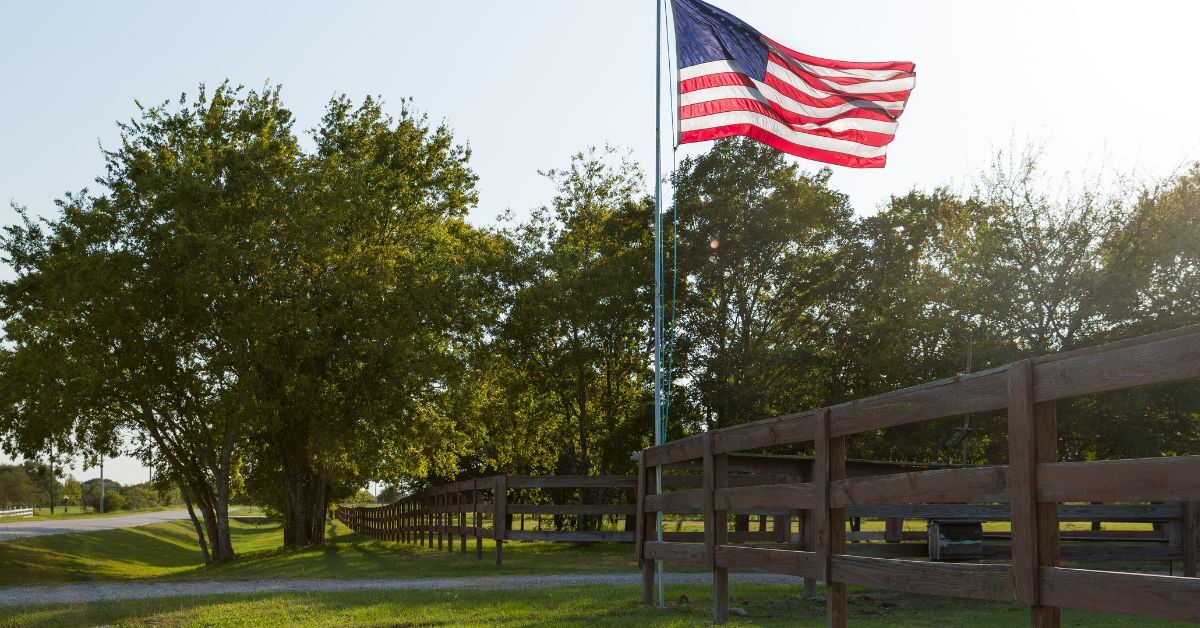Step-by-Step Guide To Installing an In-Ground Flagpole
Jul 25th 2025
Installing an in-ground flagpole is a straightforward project that lets you proudly display your flag while enhancing the visual appeal of your property. Whether you want the flagpole to stand in your front yard, backyard, or a commercial setting, following the right steps will simplify the process and give you a secure, long-lasting installation. This step-by-step guide to installing an in-ground flagpole helps preserve your property while also making flying flags easy!
Select the Right Location
Choose a location that is clear of power lines, trees, buildings, and any other structures that might obstruct the flag or pose safety risks. Ensure you have enough space not just for the flagpole but also for the flag to fly freely without obstructions. Additionally, consider visibility. Pick a spot where you’ll prominently display the flag, and people can see it from different angles. A clear, unobstructed area with good visibility works best.
Determine the Pole Height
Decide on the appropriate height of your flagpole based on the surroundings and your specific needs. Residential flagpoles typically range from 15 to 25 feet, with 20 feet being the most common size for home use.
For larger properties or commercial spaces, taller poles, such as those 30 feet or higher, might make more sense. Keep in mind the proportion of the flag to the pole’s height, as well as local zoning codes or HOA regulations that may restrict pole height in your area.
Gather Your Tools and Materials
Before starting, make sure you have all the necessary tools and materials to complete the installation efficiently. You’ll need a flagpole kit (which usually includes the pole, halyard, cleat, pulley, and ground sleeve), a post-hole digger or auger, quick-set concrete, gravel for drainage, a level, a tape measure, a bucket for mixing, and water. Having everything ready ahead of time will save you from unnecessary delays during the process.

Dig the Hole
Using a post-hole digger or an auger, create a hole where the base of the flagpole will sit. The hole should be 1.5 to 2 feet deep and about 12 inches in diameter, depending on the size of your flagpole and the specifications provided in your flagpole kit instructions. A deeper hole may be necessary for taller poles or in areas with soft soil, as this ensures better stability.
Add Gravel for Drainage
Add approximately 6 inches of gravel to the bottom of the hole to improve drainage. Gravel helps prevent water from pooling around the base, which could lead to instability or corrosion of the pole over time. Use a rake or your hands to level the gravel layer before proceeding to the next step.
Insert the Ground Sleeve
Carefully place the ground sleeve into the center of the hole, ensuring it sits upright and centered. The ground sleeve serves as the anchor for your flagpole, so it’s critical to position it correctly. Refer to your flagpole kit instructions to determine the exact placement depth for the sleeve, as this can vary depending on the height and weight of the pole.
Level the Sleeve
Use a level to check that the ground sleeve is perfectly vertical in the hole. Adjust it as needed to achieve proper alignment. This step is important because even a minor misalignment can cause the flagpole to tilt when installed. Take your time to ensure the sleeve is straight before moving forward.
Mix the Concrete
Prepare your quick-set concrete by following the manufacturer’s mixing instructions. Use a bucket or a wheelbarrow to combine the cement with water, mixing until the consistency is smooth and free of lumps. Quick-set concrete is ideal because it hardens faster, allowing for a more efficient installation process.
Fill the Hole With Concrete
Pour the wet concrete evenly around the ground sleeve, ensuring it fills the hole completely up to about an inch below ground level. Use a trowel or a stick to smooth the surface and remove any air pockets. Leave a small gap at the top of the hole to add soil later, which will help the installation blend naturally with the surrounding landscape.

Recheck the Sleeve Alignment
Before the concrete sets, use the level once again to confirm that the ground sleeve remains perfectly vertical. A slight tilt now could compromise the stability of the entire installation, so take your time and make any necessary adjustments immediately.
The concrete will begin to harden quickly, so it’s essential to act fast. Ensuring a proper alignment at this stage is crucial for the long-term stability and performance of the flagpole, especially during strong winds or severe weather.
Allow the Concrete To Set
Let the concrete dry and cure for at least 24 hours without moving or disturbing the ground sleeve. During this time, be careful to avoid any accidental bumps or adjustments that could affect the alignment.
Depending on the weather, humidity, and the specific type of concrete mix you’re using, the curing time may vary slightly. Hot, dry conditions might speed up the process, while cooler or wetter weather can slow it down. Taking the proper time to let it cure will ensure a strong, durable base for your flagpole that stands the test of time.
Assemble the Flagpole
While waiting for the concrete to set, assemble the flagpole according to the manufacturer’s instructions. This process typically involves connecting the sections of the pole, attaching the halyard (the rope used to raise and lower the flag), and fastening any accessories, such as the cleat and pulley. Double-check that all parts are securely attached to ensure smooth operation once you’ve installed the pole.
Insert the Flagpole Into the Sleeve
Once the concrete has fully cured, carefully lift the flagpole and insert it into the ground sleeve. Depending on the pole’s height and weight, you may need assistance to position it safely. Ensure the pole fits snugly and sits securely in the sleeve. If your flagpole kit includes a locking mechanism for the sleeve, engage it at this time.
Test the Flagpole
Raise and lower the halyard several times to ensure it moves smoothly without any snags or resistance. Check that the flagpole is standing perfectly straight and stable, adjusting its position if necessary to avoid leaning.
Once everything is secure, attach your flag to the halyard clips and test-fly it by raising it to the top of the pole. With the flagpole now fully installed and tested, you’re ready to display your flag proudly and enjoy your accomplished project.
Installing an in-ground flagpole doesn’t have to be a daunting task, and this step-by-step guide makes the process much more manageable. By following these steps, you can create a lasting feature that enhances the beauty and functionality of your property. This guide provides all the practical information you need to handle the process, but you also need the right in-ground flagpoles from us at Independence Bunting & Flag! With us on your side, you can install your flagpole confidently and successfully!








